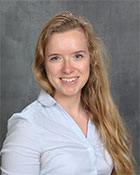To advance our understanding of biological processes, Vivian Merk, Ph.D., assistant professor of chemistry in the Charles E. Schmidt College of Science, uses an interdisciplinary approach and cutting-edge experimental techniques to examine inorganic structures that provide support, protection and storage for living organisms.
Merk is particularly interested in analyzing natural biomineralized structures and developing bio-inspired composite materials for real-world applications, such as biomedical engineering, construction and environmental engineering. Her research addresses common problems in health care, including a patent-pending innovation to mitigate hospital-acquired infections through improvements in wound care. She is also interested in developing solutions to combat harmful algae blooms and reduce global warming. Merk’s goal is to translate these innovations from the lab to the market so they can directly benefit people.
Prior to her appointment at FAU, Merk received her bachelor’s and master’s degrees in chemistry from the University of Duisurg-Essen, Germany. She earned a doctorate degree in civil engineering from ETH Zurich, Switzerland.
How did you first become interested in bioinorganic materials?
The goal of my doctoral thesis was to improve the macroscopic properties of wood (e.g., making it more fire-resistant) by incorporating inorganic minerals in the cell wall structure. I highly enjoy interdisciplinary research at the intersection of chemistry, biology, materials science, and engineering. I find it particularly intriguing that many biomineralized structures span multiple scales and levels of hierarchy. A benefit of this research is that it advances our fundamental understanding of biological structures, while providing tangible real-world applications in biomedical engineering, construction, or environmental engineering.
How do you see your research benefiting the public?
My research contributes to a better understanding of fundamental biomineralization processes in nature. Many of the research projects address pressing health care problems, such as chitosan-based wound dressings that mitigate nosocomial infections. Other projects in the lab directly benefit the environment by combating harmful algae blooms or by addressing global warming through carbon dioxide absorption in seawater.
What is your most interesting research accomplishment?
I find it very interesting how minerals align within complex organic scaffolds. Our lab has made significant strides in developing protocols for nanoscale imaging of challenging biological materials, such as hydrogels or cyanobacteria, in the near-native state.
In the next 5 years, what new developments and innovations can we expect to see in your research?
I am expecting that my group will continue developing materials based on natural and widely available raw materials that can compete with conventional plastics. I hope that some of these innovations will eventually evolve into consumer products.
Discuss a positive experience with the Office of Technology Development.
The Office of Technology Development was immensely helpful throughout the patent application process, including consultations on patent protection and commercialization strategies. The undergraduate student and co-inventor, Satviki Singh, had the unique opportunity to present our invention at the Next Generation Inventors Session of the 2022 National Academy of Inventors Annual Meeting in Phoenix, Ariz.
What is an interesting fact that people at FAU may not know about you?
Only a few people know that one of my hobbies is painting.
